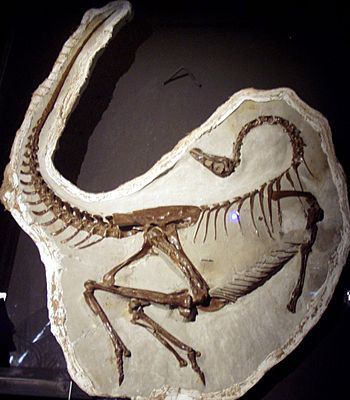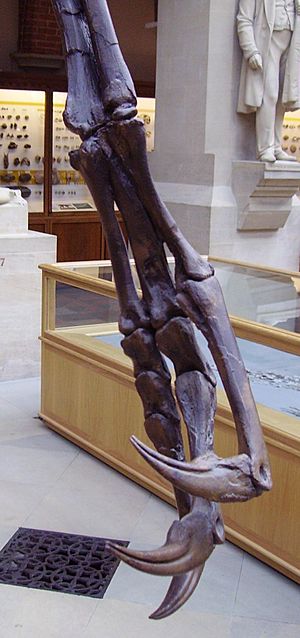Ornithomimids facts for kids
Quick facts for kids Ornithomimids |
|
|---|---|
 |
|
| Ornithomimus specimen found in 1995 with quill knobs, Royal Tyrrell Museum. | |
| Scientific classification |
|
| Kingdom: | Animalia |
| Phylum: | Chordata |
| Clade: | Dinosauria |
| Clade: | Saurischia |
| Clade: | Theropoda |
| Clade: | †Ornithomimosauria |
| Superfamily: | †Ornithomimoidea |
| Family: | †Ornithomimidae Marsh, 1890 |
| Type species | |
| †Ornithomimus velox Marsh, 1890
|
|
| Subgroups | |
|
|
| Synonyms | |
|
|
Ornithomimidae (say "Or-nith-oh-MIME-ih-day") means "bird-mimics." This group of theropod dinosaurs looked a lot like modern ostriches. They were fast dinosaurs that lived during the Upper Cretaceous period. This was about 92 to 66 million years ago.
Ornithomimids lived in a supercontinent called Laurasia. Today, this land is Asia and North America. Some well-known ornithomimids include Gallimimus, Archaeornithomimus, Anserimimus, Struthiomimus, and Ornithomimus.
What They Looked Like
Ornithomimids had many features similar to birds, like feathers. However, they were not birds themselves. They were closely related to another group of dinosaurs called troodontids.
Head and Neck
The skulls of ornithomimids were quite small. They had large eyes, which helped them see well. Their necks were long and slender, like a bird's. All ornithomimids had beaks, but they did not have any teeth.
Limbs and Claws
Their front limbs, or "arms," were long and thin. They had strong claws on their hands. Their back legs were long and powerful, perfect for running fast. They had long feet with short, strong toes. These toes ended in hoof-like claws.
What They Ate
Scientists believe that ornithomimids mostly ate plants. Many of these dinosaurs, even the older types, have been found with gastroliths in their stomachs. Gastroliths are small stones that some animals swallow to help them grind up tough plant material in their stomachs. This is a common feature in plant-eating animals.
Henry Fairfield Osborn, a famous paleontologist, thought that their long, "sloth-like" arms might have been used to pull down branches. This would have helped them reach leaves and other plant food. Further studies of their strange, hook-like hands support this idea.
Ornithomimids were very common, especially in North America. There were many of them, which fits the idea that they were plant eaters. In an ecosystem, there are usually more plant-eating animals than meat-eating ones. However, some scientists think they might have been omnivores. This means they would have eaten both plants and small animals.
See also
 In Spanish: Ornitomímidos para niños
In Spanish: Ornitomímidos para niños


